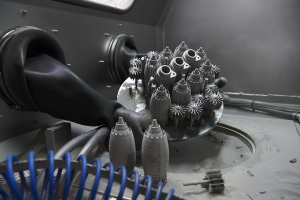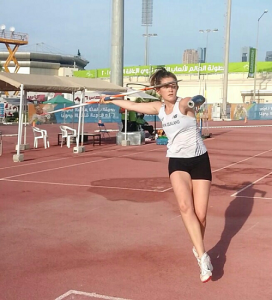New Zealand-based Zenith Tecnica, which is the only company in the country using Electron Beam Melting (EBM) technology to make 3D printed titanium components, is teaming up with High Performance Sports NZ (HPSNZ) to give two inspiring Kiwi athletes a competitive edge for the Tokyo 2020 Paralympics. Through this collaboration, the two companies will produce tailored 3D printed prosthetics for esteemed para-athletes Anna Grimaldi and Holly Robinson to use while working out and training in the gym.
3D printing has been used multiple times to help disabled athletes get a leg up over their competition, with prosthetics and braces as some of the main applications. As Zenith Tecnica, headquartered in Auckland, has supplied EBM 3D printed titanium components to America’s Cup Regatta and Formula 1 teams, fabricated plenty of medical instruments and implants, and manufactured components in outer space, the company was more than up to the challenge of making advanced, tailored prosthetics for Grimaldi and Robinson.
“Zenith Tecnica 3D printed the new attachment for Holly and Anna to use in the gym,” said Dr Stafford Murray, HPSNZ Head of Innovation. “It’s providing them with something different that you can’t buy off the shelf, that enables them to be the best that they can be.”
The company utilizes the Arcam Q10 plus and Q20 plus systems to produce EBM parts for multiple industries. These 3D printers are built on breakthrough deflection electronics, which allow for extremely accurate, fast beam control so melting can occur simultaneously at more than one point, while still maintaining excellent speed, precision, and surface finish. In addition, its hot vacuum process means no residual stresses to distort the 3D printed components.
“Zenith Tecnica offers a freedom of design to a lot of engineers, so we are not constrained to classical manufacturing methods like machining and casting,” explained Peter Sefont, the Production Manager at Zenith Tecnica. “It allows us and the engineers to do whatever we want.”
HPSNZ is a leader in sports innovation, and works with National Sporting Organisations (NSOs) to identify athletes’ strengths and push them further with modern technology and sports science. By partnering with Zenith Tecnica and using its EBM titanium 3D printing expertise, the company is able to think about the possibilities of design in a new way and knock down any boundaries that would otherwise limit them.
“To have someone listen to what we need and be like, ‘Nothing is off the table, we can try and build whatever it is you need,’ that was really awesome,” Grimaldi said about the teamwork between HPSNZ and Zenith Tecnica.
These two fierce female para-athletes are simply amazing. Robinson won the silver medal in the Women’s Javelin F46 at both the Rio 2016 Paralympics and the 2018 Gold Coast Commonwealth Games. She’s already thrown her personal best – 45.73 m – which was good enough to break the world record in the event at the Australian Track & Field Championships in Sydney this past weekend.
Grimaldi won the gold in the Women’s Long Jump T47 at the Rio 2016 Paralympics and came in fourth in the Women’s 100m T47 at the same competition. This coming June, both women will have an optimal opportunity to see if their new 3D printed training prosthetics can help them win at the 2019 Oceania Area and Combined Events Championships.
Raylene Bates, Athletics New Zealand high performance coach, said, “This is a piece of equipment that would enable them to train like an able-bodied person; granting the use of both arms with a full range of movement, achieving a full body balance.”
Of course, all of these competitions are a precursor to the main event both Robinson and Grimaldi are working towards – the 2020 Paralympics in Tokyo. The hope is that through this partnership between Zenith Tecnica and HPSNZ, their new 3D printed titanium prosthetics will help them up their game while preparing for next year’s competition. Because these will be prosthetics tailored specifically to them, exercises and training methods that the para-athletes were previously unable to do because of previous off-the-shelf prosthetics should now be entirely possible…which means that gold medals are possible as well.
Discuss this inspiring story, and other 3D printing topics, at 3DPrintBoard.com or share your thoughts in the Facebook comments below.
Subscribe to Our Email Newsletter
Stay up-to-date on all the latest news from the 3D printing industry and receive information and offers from third party vendors.
You May Also Like
3D Printing Unpeeled: Biofuel Waste to Filament & Sustainable Photopolymers
I can’t ever remember a day with so many potentially high impact news stories have come out. In one story, we all know that there are problems with the safety...
Finnair Hires AM Craft to 3D Print Plastic Parts for Aircraft Interiors
Riga-based AM Craft, a supplier specialized in 3D printing aviation components and certified under EASA Part 21G, announced a significant achievement today. The company will assist in upgrading Finnair’s A320...
3DPOD Episode 198: High Speed Sintering with Neil Hopkinson, VP of AM at Stratasys
Neil Hopkinson, a pioneering 3D printing researcher, played a pivotal role in developing a body of research that is widely utilized today. He also invented High Speed Sintering (HSS), also...
3D Printing Webinar and Event Roundup: May 12, 2024
Webinars and events are picking up in the AM industry this week! ASTM International continues its Professional Certificate Course and Stratasys continues its advanced in-person trainings, while 3D Systems is...





































